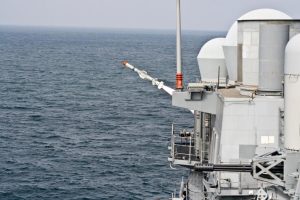The United States does not lack friends in the Indo-Pacific. It lacks a regulatory pathway to let those friends help fill the munitions gap that slows deliveries to Taiwan and stretches U.S. production lines.
The most pragmatic way to reduce Taiwan’s arms-sales backlog, and shorten the queue for other allies, is to make targeted, mission-driven changes to U.S. export controls, starting with the International Traffic in Arms Regulations (ITAR), so Japan and other critical allies can co-produce the components and subassemblies we need most.
Taiwan’s arms sales backlog is measured in the tens of billions of dollars. The stickiest delays involve munitions and key subsystems, especially seekers and solid-rocket motors, with related items like radomes and launch canisters also showing up as capacity and scheduling constraints across programs. These chokepoints directly slow deliveries to Taiwan and, because they share U.S. lines, lengthen the queue for other allies. These are industrial delays, not political ones. Because the same U.S. lines also feed other foreign military sales, every month a Taiwan order slips becomes months other allies wait, too.
Washington already demonstrated how to cut red tape without compromising security. In 2024, the State Department implemented an AUKUS ITAR framework for the United Kingdom and Australia, combining an exemption structure with expedited licensing lanes and a published “excluded items” list. In plain English: more approval, with guardrails. What should be next is a Japanese addendum of that model for a tightly scoped list of low sensitivity munitions subassemblies, and only those subassemblies.
Why Japan? Because the capacity exists today. Tokyo is modernizing its defense industry policy and seeking deeper co-production with the United States. Beyond this, Japan is an essential intelligence and treaty ally, operating U.S.-origin systems at scale. Further, Japan harnesses the capability to stand up additional production for components that are gating U.S. output, without touching crown-jewel technologies or sensitive design authority.
The policy objective is simple: let Japan build the parts, under strict controls, that are currently constraining U.S. delivery timelines to Taiwan. Taiwan benefits directly, because faster component flow into U.S. and prime contractor lines turns into earlier shipments of finished rounds. It also benefits every other ally stuck behind the same bottlenecks. Instead of offshoring U.S. jobs, this is onshoring capacity into the alliance.
Here’s what to do now:
First, create a “Trusted Munitions Agreement,” Washington should stand up an AUKUS-style ITAR construct limited to Japan for a published list of eligible subassemblies (rocket-motor shells and liners, canisters, radomes, certain seeker elements, and selected propulsion parts). Pair it with an explicit exclusions annex (no sensitive seekers, no advanced EW, no crown jewel composites), authorized-user lists, facility vetting, and intrusive compliance auditing. Copy the AUKUS playbook, but change the parties and line items.
Second, authorize build-to-print technical-data transfers – only to Japan. Issue narrowly scoped approvals that let Japanese firms manufacture to U.S. primes’ prints and processes. IP stays with the primes, while allies make parts to spec. Tie volumes to measurable backlog draw-down targets and sunset authorities that don’t hit milestones. This squarely targets the chokepoints that are pushing deliveries of high-demand munitions into later years.
Third, aggregate demand with multi-year, multi-buyer surge contracts. Publish predictable offtake. Pool U.S., Japanese, and allied orders for air-defense interceptors, anti-ship missiles, and precision-guided rockets into multi-year arrangements with minimum-buy floors. That de-risks new lines and second-source tooling. Use existing Title 10 authorities and NTIB intent to privilege Trusted-Agreement sources for surge.
Fourth, shift licensing from case-by-case to category-by-category. Borrow the AUKUS structure: standardized categories for pre-approved items, a transparent exception process for excluded items, and a service-level agreement for decisions (e.g., 45 days). Predictability is the only credible incentive for factories to add shifts and machines.
Security concerns are legitimate, but addressable. The model relies on vetted facilities, authorized-user lists, end-use monitoring, and a living exclusions annex. Keep the crown jewels in the United States, but let allies make the steel, composites, and electromechanical assemblies the U.S. cannot produce fast enough. The compliance burden should be heavy where it matters (intrusive audits, data-handling rules) and light where it doesn’t (routine, repeatable parts to print).
What about Taiwan? Even without exemptions or production on the island, Taiwan benefits first and most. Its backlog is dominated by munitions that share supply chains with U.S. and allied stocks. If Japan can turn out qualified rocket-motor casings and canisters or selected seeker components, U.S. primes can assemble finished rounds faster and shorten delivery timelines. That means earlier magazines for Taiwan, greater depth for U.S. inventories, and shorter waits for European and Indo-Pacific partners buying from the same lines.
Deterrence in the Taiwan Strait hinges on throughput, not announcements. The United States can keep approving sales, pushing into the out-years, or it can rewire export controls, turning allied goodwill into actual inventory. This plan does exactly that, unlocking near-term capacity without compromising what must remain protected, measurably reducing Taiwan’s backlog while decongesting the queue for everyone else.
We don’t need to reinvent the regulatory wheel. We need to steer it toward allies who can help build parts, right now, that turn purchase orders into delivered deterrence.





























